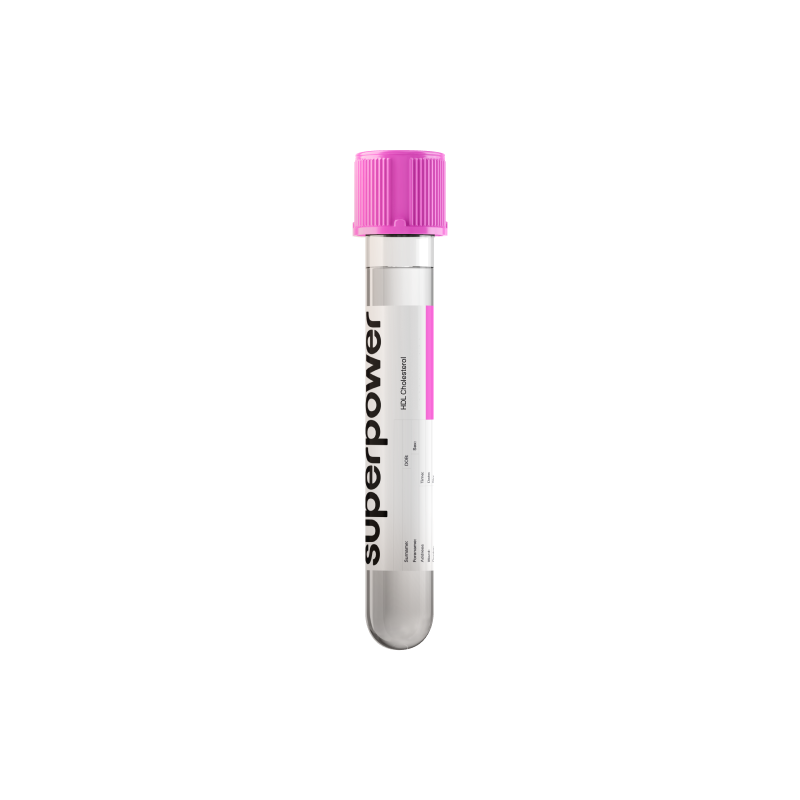Get clear insights into your reverse cholesterol transport, a key process in removing cholesterol from arteries.
HDL testing shows how lifestyle, hormones, and metabolic health influence your risk profile and helps guide smarter follow-up with other lipid markers.
Key Benefits
- Understand your “good” cholesterol that helps remove excess cholesterol from arteries.
- Spot low HDL that signals higher lifetime risk for heart attack and stroke.
- Flag very high HDL that may not be protective and warrants clinical review.
- Guide lifestyle steps—exercise, weight loss, diet, and quitting smoking—to improve HDL.
- Clarify that raising HDL with medication hasn't lowered events; prioritize LDL reduction.
- Flag metabolic syndrome risk tied to PCOS, fertility challenges, and pregnancy complications.
- Track changes across life stages, diabetes control, and menopause to monitor cardiovascular risk.
- Interpret alongside a full lipid panel and your 10-year heart disease and stroke risk score.
What is HDL Cholesterol?
HDL cholesterol is the cholesterol riding inside high‑density lipoprotein particles in your blood. HDL particles are small, protein‑rich carriers assembled mainly by the liver and small intestine. They’re built around a key scaffold protein called apolipoprotein A‑I (apoA‑I). As these particles circulate, they gather free cholesterol from cell surfaces and from other lipoproteins; enzymes then tuck it into the HDL core as cholesterol esters. An “HDL cholesterol” result sums the cholesterol contained in all HDL particles.
HDL’s central job is to shuttle excess cholesterol away from tissues and artery walls back to the liver for reuse or disposal (reverse cholesterol transport). In doing so, HDL helps maintain healthy cell membranes and supports the vessel lining. HDL particles also carry protective enzymes and signaling lipids that temper inflammation and oxidative stress in the circulation, and they assist cross‑talk between the blood and the immune and vascular systems. In practical terms, HDL cholesterol reflects the circulating pool of these retrieval‑and‑protection carriers, which enable the body to clear surplus cholesterol and keep it moving to where it belongs.
Why is HDL Cholesterol important?
HDL cholesterol is the blood’s cleanup crew. These particles shuttle excess cholesterol away from artery walls back to the liver, dampen inflammation, protect the vessel lining, and help keep blood flow responsive. Because of this “reverse transport” and anti-inflammatory work, HDL is a marker of how resilient your cardiovascular system is.
Most adults fall roughly in the 40–60 range. In general, cardioprotection tends to improve as HDL moves into the higher end, often around the 50s–70s. Women usually run higher than men, partly due to estrogen’s effects. Numbers reflect particle quantity, but function matters too.
When HDL is low—below about 40 in men and 50 in women—it often signals insulin resistance, high triglycerides, and visceral fat. The particles are fewer and often less effective at clearing cholesterol and calming inflammation. This quiets the vessel’s repair system, accelerates plaque buildup, and can travel with fatty liver and rising blood pressure. It’s usually symptomless, but risk shows up over years. After menopause, lower HDL in women is more common. In teens and children, low HDL tends to track with obesity and metabolic syndrome. During pregnancy, unusually low HDL has been linked with higher risks of glucose and blood-pressure complications.
Higher HDL—above about 60—is generally favorable. However, very high levels (near or above 90–100) are not always protective; they can reflect genetic variants or “dysfunctional” HDL, and in some studies have been linked to higher cardiovascular risk depending on context.
Big picture: HDL sits at the crossroads of lipid transport, liver function, vascular health, and metabolism. Interpreting it alongside LDL/apoB, triglycerides, glucose control, and inflammation gives the clearest view of long‑term heart and brain outcomes.
What Insights Will I Get?
HDL cholesterol measures the cholesterol carried by high‑density lipoprotein particles. These particles shuttle cholesterol out of tissues and vessel walls back to the liver (reverse cholesterol transport), help maintain endothelial function, and carry antioxidant and immune‑modulating proteins. In systems terms, HDL supports vascular integrity, metabolic flexibility, innate immunity, and delivery of cholesterol for steroid hormone production.
Low values usually reflect impaired HDL production or function, commonly seen with insulin resistance, high triglycerides, type 2 diabetes, chronic kidney or liver disease, androgen excess, or chronic inflammation. The result is less cholesterol efflux, more atherogenic remnant particles, and a pro‑inflammatory vascular milieu. Men tend to have lower HDL than premenopausal women; values can be lower with aging and in the postpartum period.
Being in range suggests effective reverse cholesterol transport, more stable endothelium, and a generally favorable cardiometabolic profile when considered alongside LDL cholesterol and triglycerides. For most adults, optimal tends to sit in the mid‑to‑higher end of the usual reference interval, without reaching extreme highs.
High values usually reflect increased HDL cholesterol content or particle number from genetic variants (e.g., CETP or SR‑B1 pathways), estrogen exposure, or certain liver conditions. Very high levels can signal “dysfunctional” HDL that is less anti‑inflammatory, and epidemiologic data show a U‑shaped relationship with risk. Women and pregnancy often show higher HDL without harm when elevations are moderate.
Notes: HDL‑C is a concentration of cholesterol, not a direct measure of HDL function; efflux capacity and particle composition can differ. Fasting is not required. Acute illness and inflammation can lower HDL. Estrogens tend to raise HDL; androgens, some beta‑blockers, and anabolic steroids can lower it. Assay methods and population norms vary by age and sex.



.svg)



.png)
.png)
.png)
.png)








